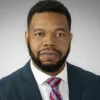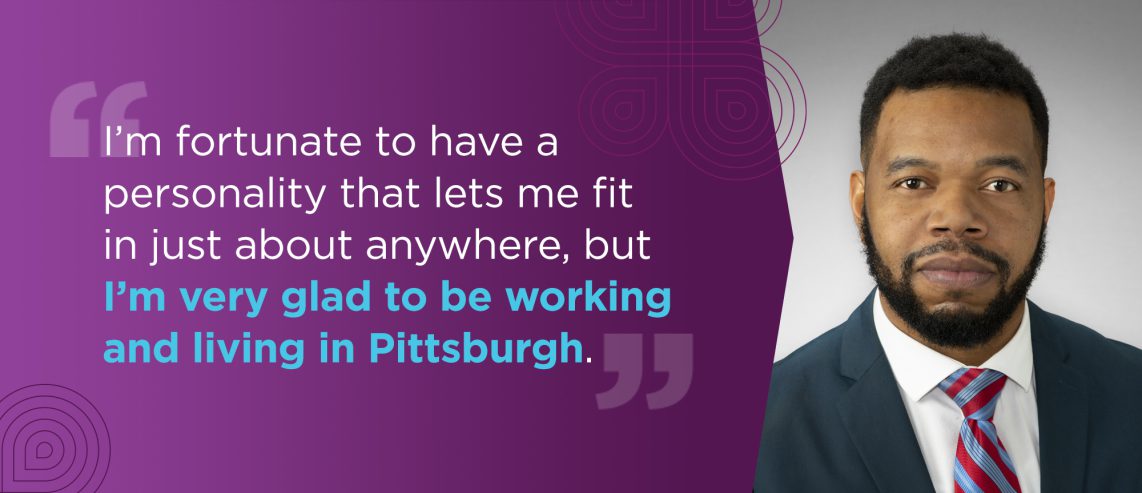Lawrence Uradu, MD, specializes in diagnostic radiology and is certified by the American Board of Radiology. He is affiliated with 17 UPMC hospitals throughout western and central Pennsylvania. Dr. Uradu also serves as assistant professor of radiology and director of Diversity, Equity, and Inclusion (DEI) for Imaging Services at the University of Pittsburgh. Dr. Uradu graduated from Marshall University’s Joan C. Edwards School of Medicine. He completed a residency at the University of Louisville Hospital and a fellowship at the University of Pittsburgh.
Your mother was a family doctor in your home country of Nigeria. Could you talk about your experiences growing up?
My mom was a medical student in Nigeria when I was born. She became our community’s general practitioner, running a clinic in the house where we lived. The clinic was downstairs, and we lived upstairs. She also did minor operations and even delivered babies.
I was never told to become a doctor. But it’s natural to gravitate to what we know best. Athletes’ kids become athletes, and yes, doctors’ kids become doctors. My four siblings and I are all in health care — one sister has a doctorate in nursing, another is a cardiac electrophysiologist, and the third is a psychiatrist. My younger brother is doing a residency in internal medicine. My wife also is from Nigeria, and she’s a pediatric endocrinologist. Her mother is a pharmacist, and her father is a cardiologist.
The odd man out is my father, who is an accountant. But he and my mother have always worked together. He came to the United States in the late 1990s, and the rest of the family moved here in stages through the early 2000s. Over the last 20 years, my parents have established three clinics in Kentucky, West Virginia, and Ohio. They still operate them today.
You entered college just after arriving in the United States. You enrolled at Morgan State University in Maryland, one of the nation’s Historically Black Colleges and Universities (HBCUs). What was that like?
Never Miss a Beat!
Subscribe to Our HealthBeat Newsletter!
Thank you for subscribing!
You can now select the specific newsletters you'd like to receive.
You are already subscribed.
Subscribe to more newsletters in our email preference center.
Sorry, an error occurred. Please try again later.
Get Healthy Tips Sent to Your Phone!
Growing up, I never even thought about race and color — we were all Nigerian! I didn’t really understand the concept until I was in college. So, it was a gift for me to attend an HBCU. I felt right at home, learned a lot, and made lifelong friends.
After graduating, my plan was to attend Howard University — another HBCU — for medical school. But my father became very ill, so I applied to the medical school closest to my parents’ home in Kentucky. For many reasons, I will always be grateful that I ended up at Marshall University in West Virginia for my medical school studies.
Did you experience any racial tension as a medical student?
During my first three years in medical school, I was the only Black student, but Marshall did a great job of welcoming me. Still, it was something of a cultural shock. I had never been immersed in an all-white community. And during my clinical experiences, there were some patients who didn’t want to be treated by a Black doctor. Sadly, some of those interactions were less than ideal.
You’ve always been passionate about increasing diversity and representation in medicine. As a medical student at Marshall, you started Project P.R.E. M.E.D. in 2011. What inspired you to do that?
The acronym stands for Providing Real World Experiences for future Marshall Educated Doctors. It’s a weeklong summer immersion program to introduce underrepresented undergraduate students to careers in medicine. It was definitely a team effort to get started, and I’m proud to say it’s still in existence today.
At the time, the medical school was looking for ways to diversify its student body. I wanted to help people understand how important it can be for students to see someone who looks like them pursuing a health care career. Representation matters. Even if the program just brought in two students, that would be more than I had in my class.
When did you decide to specialize in radiology?
My mom actually planted the seed when I was a kid playing video games. She’d stop by my room and say, “This room is so dark; how do you know where you are and where you’re going?'” One day, she said, “With the skill set you’re building, you’d be an excellent radiologist.” I had no idea then what a radiologist was, but her comment stuck with me.
Flash forward to med school. I intended to become a surgeon, but I quickly discovered it wasn’t for me: I couldn’t put things back together! I was going to shift to family medicine like my mother, but then I remembered her comment. I went down to visit the radiology department — and left with a mentor.
I never regretted the decision. I love what I do. Although I’m largely able to work remotely from home, I can impact the life of someone down the street or across the country. I still get excited seeing things that nobody else can see and figuring things out that others cannot. And I love being able to interact with and speak the languages of so many different medical specialists — whether it’s a transplant surgeon, an ER doc, or a neurologist.
There seems to be a growing commitment to greater Diversity, Equity, and Inclusion in radiology. How is that supporting your work at UPMC and Pitt?
Historically, radiology has not been particularly diverse. Like most medical specializations, it was very homogeneous — a predominantly white male field. But today, the American College of Radiology (ACR) and other professional organizations are coming together to change that balance and welcome underrepresented groups. I’m proud that as a profession, we are asking how radiology can contribute its voice to create change.
In my DEI role at UPMC, I look to see how ACR’s initiatives are aligning with what we’re doing locally. And then I ask, “How we can do better?” How can we address the disparities in cancer screenings between Black and white people for breast and colon cancer? How can we impact situational disparities — like the fact that white patients are statistically more likely to get advanced imaging than Blacks when getting emergency care? How can we educate our doctors and technicians to the unique needs of our LGBTQIA+ patients?
Positive change must start from the top. When leadership support is in place, it’s much easier for ground-level change to happen. The Department of Radiology at UPMC and the University of Pittsburgh have made major commitments to this effort, starting with our chair, Jules Sumkin, DO. It was Dr. Sumkin who tapped me to take on our DEI initiatives.
We’ve had good early success attracting more underrepresented radiology residents to Pitt. It’s been a team effort with my colleague Marion Hughes, MD, director of the residency program, and the support of UPMC Graduate Medical Education. But we know it’s not enough to simply recruit these residents. We must help them thrive once they’re here. That’s why we’re working with other Pitt and UPMC colleagues involved in DEI efforts, like Ricki Tripp, MD, to create a network of strong social, professional, and Pittsburgh connections.
We also show our commitment to DEI through educational initiatives. One of our residents, Jiun-Yiing Hu, MD, has been a tremendous resource in our efforts to develop a meaningful DEI curriculum with four or five lectures a year. She actually delivered the first lecture and was incredible! Our goal is to raise awareness about racial, cultural, and gender considerations in radiology.
And recruiting quality new faculty like Michael Chigoziri Lewis, MD, a pediatric interventional radiologist who just joined us, remains a high priority. Moving forward, I believe there also are great opportunities and benefits to be found by training, nurturing, and retaining candidates from our training program.
There’s a serious shortage of imaging technicians. In response, at UPMC, we are working to increase racial and gender diversity among our imaging techs — a field that is predominately white and predominantly female. Our goal is to reach out to high schools and community colleges to introduce underrepresented people to imaging careers. We also need to look for ways to incentivize them, such as tuition support.
As a Nigerian American, what’s it like to live, work and establish a family in Pittsburgh?
I’m fortunate to have a personality that lets me fit in just about anywhere, but I’m very glad to be working and living in Pittsburgh. My UPMC experience has been especially great because the people there see more me in than I see in myself. They choose to focus more on potential than limitations.
My wife and I are very involved in the community. We’re putting down so many roots in Pittsburgh that I think we’re going to be here a while (but I’ll always be a Ravens fan!). Pittsburgh may not be perfect, but like my UPMC colleagues, I see more of its potential than its shortcomings. In terms of advancing DEI, I’m seeing great efforts underway — from UPMC, Mayor Ed Gainey, and local groups like Operation Better Block, Neighborhood Allies, and the Urban Redevelopment Authority, among others. I think Pittsburgh has the opportunity to become one of the best cities in the country. I can’t wait to see what the city will look like five or 10 years from now.
Editor's Note: This article was originally published on , and was last reviewed on .
About UPMC
Headquartered in Pittsburgh, UPMC is a world-renowned health care provider and insurer. We operate 40 hospitals and 800 doctors’ offices and outpatient centers, with locations throughout Pennsylvania, Maryland, New York, West Virginia, and internationally. We employ 4,900 physicians, and we are leaders in clinical care, groundbreaking research, and treatment breakthroughs. U.S. News & World Report consistently ranks UPMC Presbyterian Shadyside as one of the nation’s best hospitals in many specialties and ranks UPMC Children’s Hospital of Pittsburgh on its Honor Roll of America’s Best Children’s Hospitals. We are dedicated to providing Life Changing Medicine to our communities.

